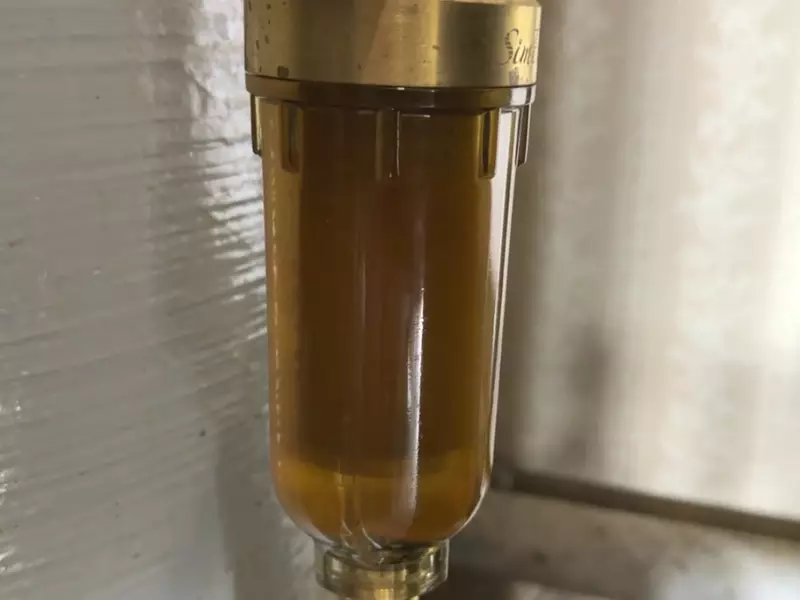Well water remains a primary source for millions globally. Its purity, freshness, and connection to natural aquifers make it an essential commodity. However, sometimes this crystal-clear resource can turn a surprising shade of orange.
Surprisingly, the main culprits behind orange well water are high iron concentrations and other minerals. These elements, although naturally occurring, can be problematic when their levels spike, leading to discoloration.
Orange discoloration in well water isn’t just about aesthetics; it comes with potential health impacts and functional problems. Knowing the causes and treatments is vital for maintaining clean and healthy well water.

Common Causes of Orange Well Water
The quality and clarity of well water can be affected by a variety of factors, ranging from natural mineral compositions to external disturbances. While seeing your clear water turn orange can be startling, understanding its root causes can help in formulating an effective solution.
Iron Presence
Iron is a naturally occurring element, making it prevalent in various water sources. However, when its concentration crosses the acceptable threshold, it becomes a cause of concern due to the changes it induces.
- Natural Occurrence: In some geographical regions, the soil is rich in iron. Groundwater in such areas tends to absorb these iron particles, leading to higher iron content in the water. Over time, as this water gets exposed to oxygen, the iron oxidizes and gives the water an orange hue.
- Iron Bacteria: Iron bacteria are microorganisms that oxidize iron to derive energy. In the process, they produce a reddish-brown slime that settles in water pipes, tanks, and appliances. This not only discolors the water but can also clog pipes and release a foul odor.
Manganese Accumulation
Manganese is another metal which, in conjunction with iron, can cause discoloration.
- Natural Sources: Just like iron, manganese is also found in the Earth’s crust. When water sources come in contact with manganese-rich rocks or soil, the metal leaches into the water.
- Combined Effects: When iron and manganese co-exist in water, they can create a compounding effect. Water might not only turn orange but could also take on a brownish or black hue.
Rust from Old Pipes and Fixtures
Infrastructure plays a pivotal role in maintaining water quality. As fixtures age, they become susceptible to corrosion.
- Rust Formation: As metal pipes and fixtures age, they can corrode, leading to rust. When water flows through these rusted channels, it picks up rust particles, leading to an orange tint.
- Infrastructure Age: Older establishments, with dated plumbing systems, are at a higher risk. Regular inspection and timely replacements can mitigate this problem.
Sediment Disturbances
Water clarity can be affected when the settled sediments are disturbed.
- Natural Disturbances: Factors such as earthquakes or heavy land movements can agitate the sediment layers in the water source.
- Human Activities: Drilling near a water source, heavy construction activities, or even the process of cleaning a well can stir up the sediments, leading to discoloration.

Impacts of Orange Well Water
While the orange hue might seem merely an aesthetic issue, it poses functional and potential health concerns that are important to understand.
Health Implications
- Digestive Issues: Consuming water with very high iron content over extended periods can lead to minor digestive disturbances. While not toxic, the iron overload can be uncomfortable for some.
- Skin Conditions: Using hard water, especially with high mineral content, for bathing can result in dry, itchy skin. It might also exacerbate certain skin conditions like eczema.
- Essential Mineral: While excess can be bothersome, it’s worth noting that iron is an essential mineral for the human body, crucial for producing red blood cells.
Staining
Iron-laden water can have far-reaching impacts beyond consumption.
- Clothing: When used for washing, clothes might get stained. White fabrics, in particular, can show visible orange or brown spots after washing.
- Fixtures: Over time, orange rings or streaks can form on fixtures like sinks, bathtubs, and toilets. This staining is not just unsightly but can also be tough to clean.
- Appliances: Washing machines, dishwashers, and even water heaters can accumulate iron residues. Over time, these deposits can affect the appliance’s efficiency and lifespan.
Taste and Odor Deviations
- Metallic Taste: High concentrations of iron and manganese can impart a metallic taste to the water, making it unpalatable.
- Odor Issues: In instances where iron bacteria are the culprits, the water might exude a rotten or swampy odor, making it unsuitable for drinking or cooking.
Treatment Options
When confronted with the issue of orange well water, there are multiple treatment options to consider, depending on the root cause.
Iron Filters
Specially designed to combat high iron content, these filters are a boon for affected households.
- Mechanism: Iron filters primarily function by oxidizing the dissolved iron, converting it to solid particles. These particles are then trapped within the filter and periodically flushed out.
- Benefits: Along with removing iron, these filters can also reduce manganese and sulfur odors, offering a comprehensive solution.
Water Softeners
Popularly known for treating hard water, softeners can be your ally against iron too.
- Ion Exchange: Water softeners use a process called ion exchange. In this, calcium and magnesium ions, which cause water hardness, are exchanged for sodium ions. In the process, iron and manganese ions are also removed.
- Added Advantage: Softened water is not only clear but also better for your skin, hair, and appliances.
Reverse Osmosis Systems
For those looking for a thorough treatment solution, reverse osmosis can be effective.
- Efficacy: These systems use a semi-permeable membrane to filter out contaminants, including iron and manganese. The result is pure, clean water free from discoloration and taste issues.
- Versatility: Apart from iron and manganese, RO systems also reduce other contaminants like lead, arsenic, and certain microbes.

Shock Chlorination
This treatment is specifically designed to eliminate iron bacteria, addressing both discoloration and odor issues.
- Method: The process involves introducing a strong chlorine solution into the well. This chlorine concentration kills iron bacteria and oxidizes iron and manganese, making them easy to filter out.
- Periodic Treatment: Depending on the severity, shock chlorination might need to be repeated periodically.
Regular Well and Pump Maintenance
To prevent the problem at its root, regular maintenance is crucial.
- Periodic Checks: Regularly inspecting the well, pump, and storage systems can help identify potential issues before they escalate. This includes checking for rusting parts, sediment build-up, or bacterial growth.
- Professional Inspection: While some checks can be DIY, it’s beneficial to have a professional inspect your well system annually. They can offer insights, recommend treatments, and ensure your water remains pristine.
Choosing the Right Treatment
Arriving at an effective solution requires a thorough understanding of the cause.
- Water Tests: Before deciding on a treatment, get your water tested. This will reveal the exact iron concentration and the presence of other contaminants, guiding the treatment choice.
- Budget Considerations: While some solutions like RO systems can be expensive, others like shock chlorination are more cost-effective. Weigh the costs against the benefits to make an informed decision.
DIY versus Professional Treatments
Venturing into DIY solutions can be tempting, but it’s crucial to understand the pros and cons.
Benefits of Professional Assistance
- Accurate Solutions: Professionals can assess the water quality, identify the root cause, and recommend targeted solutions.
- Safety: Handling chemicals, especially for treatments like shock chlorination, can be risky. Professionals ensure safe and effective application.
Risks of DIY Methods
- Incomplete Solutions: Without a proper understanding, DIY treatments might address the symptoms but not the root cause.
- Potential Damage: Incorrect dosages or using inappropriate chemicals can exacerbate the problem or introduce new issues.
Cost Implications
- Immediate Costs: While professional treatments might seem expensive upfront, they offer long-term solutions, making them cost-effective in the long run.
- Hidden Costs: DIY treatments, if done incorrectly, can lead to additional expenses. This includes potential damages to the well system or the need for repeated treatments.
Preventive Measures
To ensure your well water remains clean and clear, a proactive approach is invaluable.
- Regular Water Testing: This will not only detect iron but also other potential contaminants. Early detection facilitates timely interventions.
- Well Cleaning: Over time, wells can accumulate sediments. Periodic cleaning helps maintain water clarity and prevents discoloration.
- Pipe and Fixture Check-ups: Regular inspections ensure that the infrastructure remains in top shape. Replace rusting parts promptly to prevent water discoloration.
- Avoiding Water Stagnation: Ensure regular water flow, especially in storage tanks. Stagnant water can lead to mineral buildup and bacterial growth.
Frequently Asked Questions
Is orange well water harmful to drink?
In most cases, the orange coloration due to iron isn’t harmful. However, it’s always recommended to test the water to ensure no other harmful contaminants are present.
Can I cook with orange-tinted water?
Yes, but it might alter the taste of the food and leave deposits on cookware.
How often should I test my well water?
It’s advised to test well water at least once a year. If there’s a noticeable change in taste, color, or odor, you should test it immediately.
Conclusion
Well water remains a popular choice due to its perceived purity. However, when discoloration occurs, it poses both health and aesthetic concerns.
Efficient treatments and regular maintenance can combat the issues that lead to orange water. Being proactive, informed, and seeking expert advice when necessary ensures that this natural resource remains pure and beneficial.